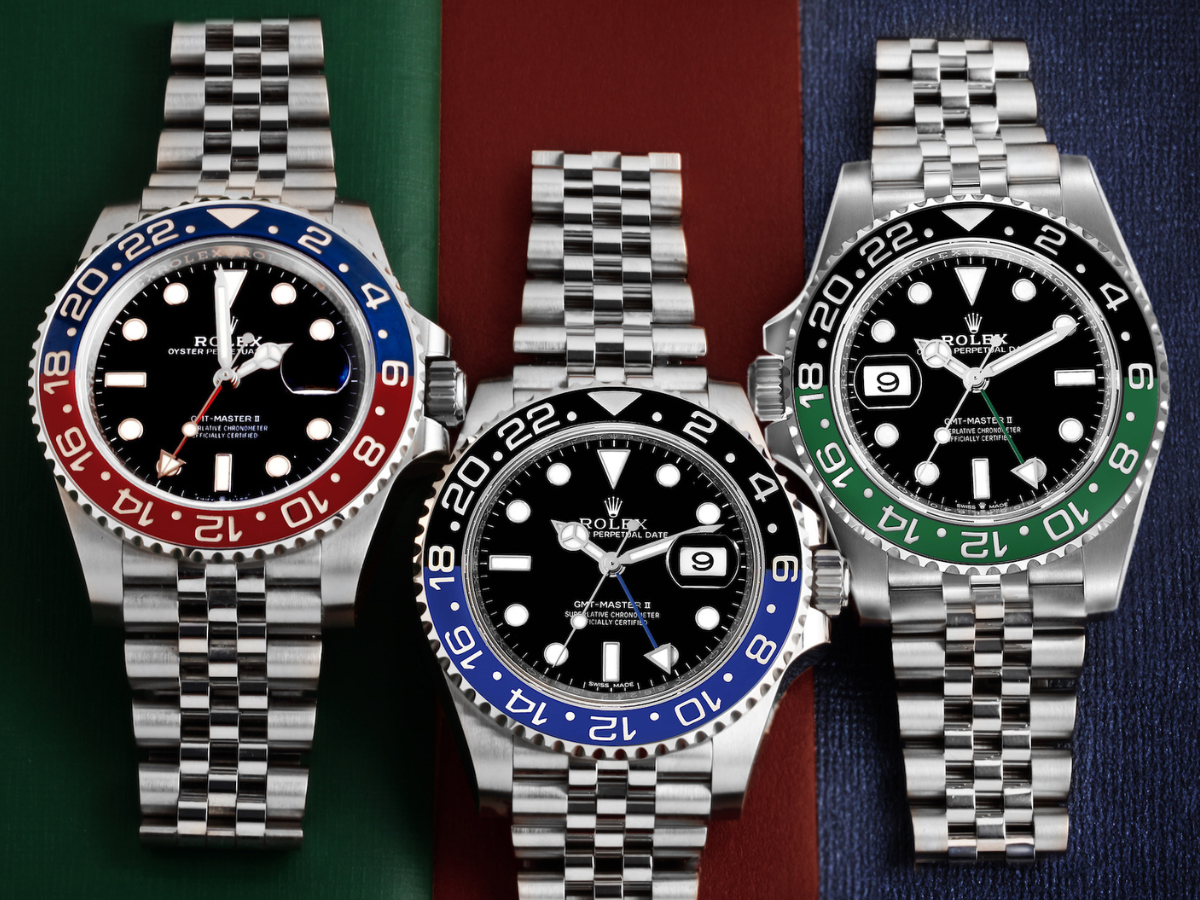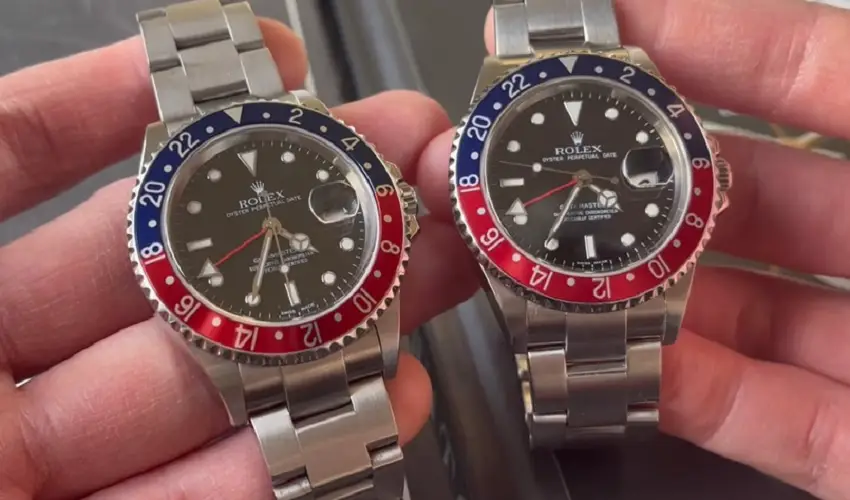The main differences between Rolex 16700 and 16710 models are the movement and the bezel design. The Rolex 16700 features the older GMT-Master II movement, while the Rolex 16710 includes the newer and improved GMT-Master II movement.
Additionally, the 16700 has a tritium dial and a steel bezel, whereas the 16710 has a luminova dial and an aluminum bezel insert.
These differences make the 16710 a more desirable choice for collectors. With its updated movement and modern design elements, the 16710 offers improved accuracy and functionality.
Overall, the Rolex 16710 is the preferred option for those seeking a more advanced and updated GMT-Master II model.
Rolex 16700 Vs Rolex 16710
Design And Features
When it comes to luxury watches, Rolex stands in a league of its own. The brand is synonymous with timeless elegance, exceptional craftsmanship, and unparalleled quality.
Two popular models, the Rolex 16700 and the Rolex 16710, showcase the brand’s commitment to excellence. In this blog post, we will compare the design and features of these two iconic timepieces.
Case And Bezel Comparison
The case and bezel of a watch play a significant role in defining its overall aesthetic appeal. Let’s take a closer look at how the Rolex 16700 and the Rolex 16710 differ in terms of their case and bezel design:
| Rolex 16700 | Rolex 16710 |
|---|---|
| The Rolex 16700 features a stainless steel case | The Rolex 16710 also boasts a stainless steel case |
| It has a black aluminum bezel insert | It comes with a bi-directional rotating bezel with a black aluminum insert |
As we can see, both models share a stainless steel case, which not only imparts durability but also lends a sophisticated look.
However, the Rolex 16710 takes it a step further with its bi-directional rotating bezel, allowing for greater functionality and ease of use. The black aluminum insert on the bezel adds a touch of contrast, enhancing its overall elegance.
Dial And Hands Variation
Another aspect that sets apart the Rolex 16700 and the Rolex 16710 is their dial and hands variation. Let’s delve deeper into this feature:
- The Rolex 16700 features a black dial with luminous hour markers and hands.
- The Rolex 16710 offers a choice between a black or a white dial, both with luminous hour markers and hands.
While the Rolex 16700 opts for a classic black dial, the Rolex 16710 provides versatility with a choice between a black or a white dial. Regardless of the dial color, both models feature luminous hour markers and hands, ensuring optimal legibility even in low-light conditions.
In conclusion, the Rolex 16700 and the Rolex 16710 exhibit subtle differences in their design and features. The Rolex 16710 takes the crown with its bi-directional rotating bezel and dial color options, offering a blend of functionality and customization.
Ultimately, the choice between these two exceptional timepieces depends on personal preferences and desired aesthetics.

Movement And Performance
The movement and performance of a watch are crucial factors to consider when comparing different Rolex models. Before making a purchase decision, it’s essential to understand the differences in the caliber, accuracy, and durability between the Rolex 16700 and 16710.
Caliber Differences
The Rolex 16700 is powered by the Caliber 3175 movement, while the 16710 features the Caliber 3185. Both movements are based on the renowned Rolex Caliber 3135 but have distinct features.
The Caliber 3185 in the 16710 includes a GMT module, allowing for the display of an additional time zone.
On the other hand, the Caliber 3175 in the 16700 lacks this feature, making it a simple dual-time function model. Additionally, the 3185 benefits from a quickset date function, which is absent in the 16700.
Accuracy And Durability
When it comes to accuracy, both models are highly reliable due to the robust nature of Rolex movements. The Caliber 3185 in the Rolex 16710 has a slight edge over the Caliber 3175 in terms of accuracy and durability.
The Caliber 3185 features a Breguet overcoil, enhancing its shock resistance and maintaining precise timekeeping in different positions. The 16700, while still an excellent timepiece, does not benefit from this specific enhancement, making the 16710 more resilient to shocks and position variations.
Historical Significance
In the realm of luxury timepieces, Rolex has maintained an unmatched reputation for excellence and precision. The historical significance of the Rolex GMT-Master II, particularly the 16700 and 16710 models, is a testament to the brand’s enduring legacy in the world of horology.
Evolution Of The Rolex Gmt-master Ii
The GMT-Master II collection holds a storied past, tracing back to the 1950s when Rolex partnered with Pan American World Airways to develop a timepiece capable of simultaneously tracking two time zones. This collaboration birthed the original GMT-Master, which quickly garnered acclaim for its innovative functionality and striking design.
As air travel became more prevalent, the demand for a watch that could display additional time zones led to the creation of the GMT-Master II. The 16700 and 16710 models stood as pivotal iterations in the evolution of this iconic timepiece, each contributing unique advancements to meet the needs of modern globetrotters and aficionados of precision timekeeping.

Collectibility And Value
Rareness And Market Demand
The rarity of a watch greatly impacts its desirability and ultimately its value. In the case of the Rolex 16700 and 16710, both models exhibit a certain level of scarcity, contributing to their collectibility. The Rolex 16700, also known as the “GMT-Master II,” was produced in relatively limited quantities from the late 1980s to the early 1990s.
It represents an appealing transitional period for Rolex as it marked the introduction of the updated caliber 3175 movement. On the other hand, the Rolex 16710, also referred to as the “GMT-Master II Pepsi,” was manufactured from the late 1980s until 2007.
The market demand for these models continues to be strong due to their association with Rolex’s GMT-Master collection, which is highly regarded for its dual-time zone functionality. Additionally, both references possess timeless aesthetics, combining sportiness with elegance.
Their notable features such as the rotating bi-directional bezel, distinctive GMT hand, and crisp dials contribute to their allure among collectors. As a result, owning either a Rolex 16700 or 16710 has become a prestigious status symbol in the watch community.
Investment Potential
Investing in luxury watches has proven to be a lucrative venture, and the Rolex 16700 and 16710 are no exceptions. These models have demonstrated remarkable appreciation in value over the years, which is a testament to their enduring desirability.
The scarcity of the Rolex 16700, combined with its historical significance as the predecessor to the GMT-Master II line, has resulted in a significant increase in its market value. Likewise, the Rolex 16710, with its striking Pepsi bezel and enduring popularity, has experienced a consistent upward trajectory in terms of investment potential.
Furthermore, Rolex watches, in general, are renowned for their ability to retain their value and even appreciate over time. Factors such as the brand’s unrivaled reputation, exceptional craftsmanship, and stringent quality control contribute to the ongoing demand for Rolex timepieces. For collectors and investors, acquiring a Rolex 16700 or 16710 presents an opportunity to not only enjoy a remarkable timepiece but also potentially realize substantial financial gain.
In conclusion, the Rolex 16700 and 16710 possess a significant collectibility and value due to their rarity, market demand, and investment potential. Whether you acquire one of these iconic watches for personal enjoyment or as a savvy investment, they undoubtedly represent a timeless piece of horological history that will continue to captivate enthusiasts for generations to come.
Popularity And Community Perception
Rolex 16700 and 16710 watches are highly coveted collectibles among watch enthusiasts. The community perception of these two models is influenced by various factors.
Collector Preferences
1. Collectors often value the historical significance and design nuances that differentiate the Rolex 16700 from the 16710. 2. Demand for these models fluctuates based on availability and rarity in the market.
Social Media Influence
1. On platforms like Instagram and Facebook, users showcase their Rolex 16700 and 16710 timepieces, influencing others. 2. Social media plays a crucial role in shaping the perception and desirability of these watches.
Personal Choice
Comparing between the Rolex 16700 and 16710, personal choice plays a crucial role. While the 16700 offers a classic GMT-Master look, the 16710 comes with an improved movement and sapphire crystal, catering to individual preferences for vintage charm or modern features.
Factors To Consider When Choosing
When selecting between the Rolex 16700 and 16710, several factors should be taken into account:
- Functionality: Consider the features you prioritize in a watch.
- Appearance: Evaluate the design and aesthetics that best suit your style.
- Price Point: Determine your budget for the investment.
- Legacy: Explore the heritage and reputation of each model.
Expert Recommendations
Experts often recommend the Rolex 16710 for its updated features and versatility:
- Dual Time Zone: Beneficial for frequent travelers or individuals managing multiple time zones.
- Updated Movement: Enhanced technical capabilities for improved accuracy.
- Aluminum vs. Ceramic Bezel: Consider the differences in material and durability.
- Collectibility: The Rolex 16710 is favored in the watch community for its potential value appreciation over time.
Frequently Asked Questions Of Rolex 16700 Vs 16710
What Are The Main Differences Between Rolex 16700 And 16710?
The main differences lie in the movement and bezel. The 16700 has a quickset date function and a non-upgraded movement, while the 16710 features an improved movement and a new bezel with a ceramic insert.
Which One Is More Suitable For Frequent Travelers, 16700 Or 16710?
For frequent travelers, the 16710 is more suitable due to its improved movement, GMT hand, and bi-directional bezel, allowing tracking of multiple time zones easily compared to the 16700.
What Are The Key Characteristics Of Rolex 16700 Or 16710 That Make Them Stand Out?
The prominent features of the 16700 and 16710 include their durable build, precision timekeeping, and iconic GMT functionality. Both models are renowned for their reliability and versatility, making them highly sought after in the luxury watch market.
Conclusion
With their subtle differences, the Rolex 16700 and 16710 models have distinct qualities that appeal to collectors and watch enthusiasts. While both showcase exceptional craftsmanship and enduring quality, the 16700 model showcases a vintage appeal with its Tritium dial and scratch-resistant sapphire crystal.
On the other hand, the 16710 model offers an upgraded GMT movement and improved stainless steel finish.
Choosing between the two depends on personal preference and desired features. Whether capturing heritage or embracing modernity, both models represent the timeless elegance that Rolex is renowned for.

